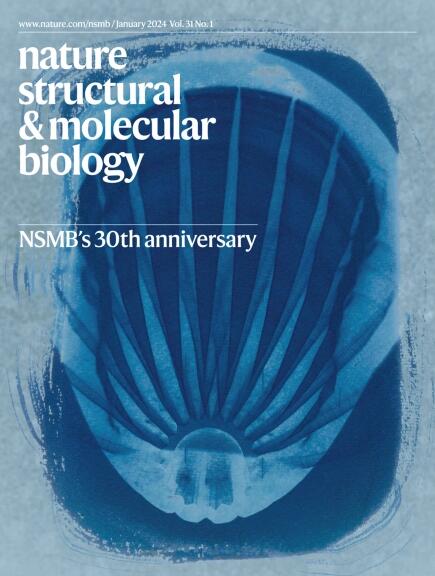真核镁通道Mrs2的封闭和开放结构揭示了自配体门控调控机制。
IF 12.5
1区 生物学
Q1 BIOCHEMISTRY & MOLECULAR BIOLOGY
引用次数: 0
摘要
CorA/Mrs2家族的五聚体蛋白是Mg2+跨细胞膜内流的主要蛋白,将阳离子输入真核生物的线粒体。然而,渗透的传导和调控机制仍然是难以捉摸的,特别是真核Mrs2成员。在这里,我们报告了封闭和开放的Mrs2冷冻电镜结构,并附有功能表征。在封闭状态下,由蛋氨酸和精氨酸残基控制的窄孔允许Mg2+通量。构象之间的转换是由位于单体之间的线粒体基质腔内的两对保守的传感器服务Mg2+结合位点协调的。在较低水平的Mg2+中,这些离子被剥离,允许另一种对称形状,由RDLR基序维持,取代开放构象中的一个传感器位点对。因此,我们的研究结果共同建立了Mrs2选择性Mg2+内流的分子基础和自配体门控调节机制。本文章由计算机程序翻译,如有差异,请以英文原文为准。

Closed and open structures of the eukaryotic magnesium channel Mrs2 reveal the auto-ligand-gating regulation mechanism
The CorA/Mrs2 family of pentameric proteins are cardinal for the influx of Mg2+ across cellular membranes, importing the cation to mitochondria in eukaryotes. Yet, the conducting and regulation mechanisms of permeation remain elusive, particularly for the eukaryotic Mrs2 members. Here, we report closed and open Mrs2 cryo-electron microscopy structures, accompanied by functional characterization. Mg2+ flux is permitted by a narrow pore, gated by methionine and arginine residues in the closed state. Transition between the conformations is orchestrated by two pairs of conserved sensor-serving Mg2+-binding sites in the mitochondrial matrix lumen, located in between monomers. At lower levels of Mg2+, these ions are stripped, permitting an alternative, symmetrical shape, maintained by the RDLR motif that replaces one of the sensor site pairs in the open conformation. Thus, our findings collectively establish the molecular basis for selective Mg2+ influx of Mrs2 and an auto-ligand-gating regulation mechanism. Here, the authors demonstrate how Mrs2, critical for import of Mg2+ into the mitochondria, transitions from open and closed five-fold symmetric states to control the influx of Mg2+ using an auto-ligand-gating regulation mechanism.
求助全文
通过发布文献求助,成功后即可免费获取论文全文。
去求助
来源期刊

Nature Structural & Molecular Biology
BIOCHEMISTRY & MOLECULAR BIOLOGY-BIOPHYSICS
CiteScore
22.00
自引率
1.80%
发文量
160
审稿时长
3-8 weeks
期刊介绍:
Nature Structural & Molecular Biology is a comprehensive platform that combines structural and molecular research. Our journal focuses on exploring the functional and mechanistic aspects of biological processes, emphasizing how molecular components collaborate to achieve a particular function. While structural data can shed light on these insights, our publication does not require them as a prerequisite.
 求助内容:
求助内容: 应助结果提醒方式:
应助结果提醒方式:


